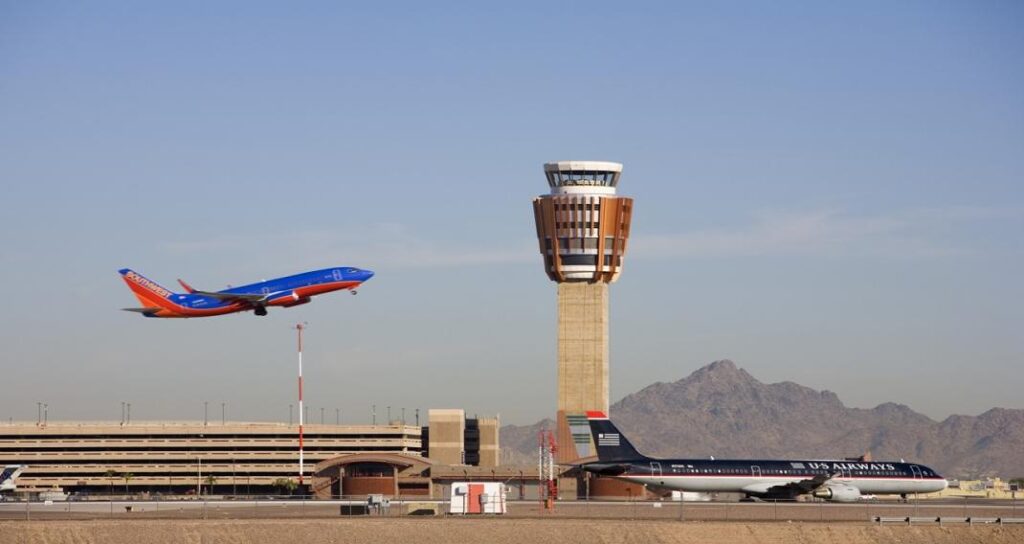
The FAA will award $20M from President Biden’s Bipartisan Infrastructure Law to 29 airport-owned traffic control towers in the U.S. Pictured above is Phoenix Sky Harbor’s Air Traffic Control Tower and TRACON. (Photo: Jacobs)
On Friday, March 31, the Federal Aviation Administration (FAA) announced it will be providing $20 million through a new bipartisan infrastructure law to help smaller airports across the country modernize their operations. The funding aims to support local economies by helping nearby airports improve safety and lower costs.
29 airports across the United States will receive funding from this new investment in infrastructure. The main purpose of the funding will be to help airports either upgrade or replace their aging control towers. Now with the needed monetary resources, airports will repair, modernize, or even replace existing air traffic control towers. Investment in better air traffic control infrastructure will help a variety of industry segments—including commercial services, flight training, and agricultural aviation—to grow and thrive, especially following unprecedented challenges caused by the pandemic.
Airports, though often seen as relevant only to the travel industry, actually play a vital role in the nation’s economy. This is especially true on a local level. As Transportation Secretary Pete Buttigieg explains, “Airports aren’t just travel hubs, they are important job centers and economic engines—especially in smaller communities. We’re proud to deliver these investments, which will help us improve safety at airports and support local economies for decades to come.”
The largest recipients of funding from the FAA are concentrated in the midwestern United States. Columbus Municipal Airport (BAK) in Indiana received the largest amount of funding, with over $1.5 million. The airport does not have any commercial service, but it is one of the fastest-growing general aviation airports in the state. While it provides necessary aviation infrastructure to southern Indiana, it is in great need of improvements. The airport’s control tower, which is 68 years old, struggles with Line of Sight challenges, can only be accessed through outdoor stairs, and fails to meet a variety of regulatory requirements that ensure safety. A new 100-foot tower will be built as a replacement using the funding.

A data visualization of the airports receiving funding (Photo: FAA)
Located in Tyler, Texas, Tyler Pounds Regional Airport (TYR) will also receive a notable proportion of the subsidies. The airport will use the $1.1 million it has been awarded to plan and create a preliminary design to relocate its existing FAA Contract Tower (FTC). A recent extension of the main runway has led to serious Line of Sight issues. Because the current facility is 75 years old, it also does not meet many Occupational Safety and Health Administration (OSHA) safety standards. Among other additions, the new facility will have an elevator, making it more compliant with standards from the Americans With Disabilities Act (ADA). Tyler Pounds Regional Airport also hosts three daily American Airlines flights to Dallas/Fort Worth International Airport, meaning that these improvements will also assist the city in ensuring smooth passenger operations.
Another major recipient of funding is Joplin Regional Airport (JLN) in Joplin, Missouri. The airport received over $800,000 to improve its current infrastructure. About $500,000 of the funding will be put toward modernizing aging equipment in the control tower. The rest of the funding will be put toward replacing the airport’s dated lighting system. In addition to providing a variety of resources for general aviation activities, the airport also has commercial service made possible by the United States’ Essential Air Service program. This program provides subsidies to airlines to fly to smaller, otherwise unprofitable destinations. Joplin’s EAS contract was awarded to Skywest Airlines (flown under the United Airlines Brand), which operates flights to both Denver International Airport (DEN) and Chicago-O’Hare International Airport (ORD). Improvements like this will help enhance the flying experience for commercial passengers.
While size was a consideration, the funding was provided to airports most in need of it. Many small airports are receiving the most funding, but some recipients of these subsidies are busier airports with more commercial traffic. For example, Eagle County Regional Airport, which sees larger passenger volumes and therefore mainline, narrow-body jets during the winter ski season, will also receive money from the government to improve its control tower. Other funding recipients that receive mainline passenger jets include Bozeman-Yellowstone International Airport, Jackson Hole Airport and Trenton-Mercer Airport.
The aviation industry has proven to be resilient despite setbacks in recent years. Across most industry segments, air traffic is returning to pre-pandemic levels. Investments in important infrastructure is critical to maintaining safety, and the FAA believes funding smaller airports with less monetary resources is a good way to support the industry during its time of recovery.